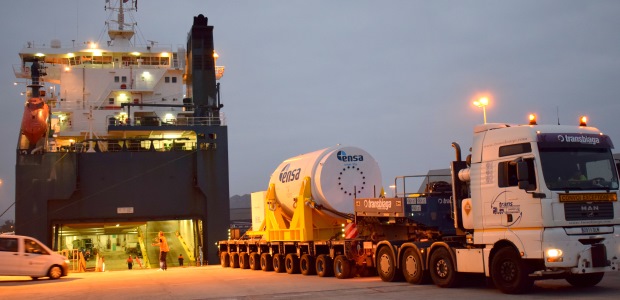
Sandia Details 'Transport Triathlon' Results
The eight-month test involved a waste transportation and storage cask fresh off the assembly line being loaded with three surrogate fuel rod assemblies from the United States, Spain, and South Korea and then traveling from Spain to Colorado and back again by truck, ship, and train.
Sandia National Laboratories, a DOE facility in Albuquerque, N.M., reported this month that its researchers completed an eight-month, 14,500-mile "transport triathlon" to gather data on the bumps and jolts spent nuclear fuel experiences during transportation. The data from their test could be used to demonstrate the safe transportation of spent nuclear fuel as it journeys from the nuclear power plants where it is generated to interim storage locations and, perhaps, eventually to a permanent geologic disposal site.
Nuclear power supplies almost 20 percent of U.S. electricity, according to Sandia's news release this month, but it produces between 2,200 and 2,600 tons of spent fuel in the United States annually. The fuel rods become brittle and highly radioactive while powering the nuclear reactor, which means safe transportation is very important.
The test involved a waste transportation and storage cask fresh off the assembly line being loaded with three surrogate fuel rod assemblies from the United States, Spain, and South Korea and then traveling from Spain to Colorado and back again by truck, ship, and train. Zirconium alloy tubes filled with lead rope, lead pellets, or molybdenum pellets imitated the uranium oxide pellets inside a spent fuel rod.
"All of our preliminary data suggests that the likelihood of a fuel rod breaking during routine handing and transportation is low. This test is more realistic than past tests and could result in a more reliable quantification of the transportation risks," explained Sylvia Saltzstein, manager of the transportation projects. For the test, Sandia collaborated with Equipos Nucleares S.A., the Spanish cask designer and manufacturer, and Empresa Nacional de Residuos Radiactivos S.A., the corporation responsible for managing nuclear waste in Spain. The Korea Radioactive Waste Agency, Korea Atomic Energy Research Institute, and DOE's Pacific Northwest and Argonne national laboratories also took part.
The "triathlon" began in Spain with truck travel, then switched to a barge for transport to Belgium, and then onto a cargo ship that crossed the Atlantic Ocean to Baltimore, where it was transferred to a railcar and traveled about 2,000 miles through a dozen states. In partnership with the Association of American Railroads, the cask and fuel assemblies were tested at the Transportation Technology Center Inc. facility near Pueblo, Colo., and afterward the cask with its sensors reversed course and returned to Spain.
The release said this "triathlon" was Sandia's fourth test to measure routine transportation strains. The first one used a shaker table to test Sandia's sensor-studded mock fuel assembly. The second test placed the same assembly on a truck trailer loaded with 50,000 pounds of concrete, the same as a transportation cask, and took it on a 38-mile trip on highways, city streets, and dirt roads. Both of these tests showed similar, very low levels of strain on the mock fuel. And the third test was of shocks and vibrations experienced riding the rails.
Analysis of the results is under way. "Preliminary results show very low shock and vibration levels, which we will compare to the mechanical properties of fuel that's come out of a nuclear power reactor," said Paul McConnell, project manager for the tests. "Ultimately, we want to understand if the fuel can withstand the accumulation of shocks and vibrations during the journey that could potentially cause a fuel rod to break."
The test was partially funded by the DOE Office of Nuclear Energy's Spent Fuel and Waste Science and Technology program.